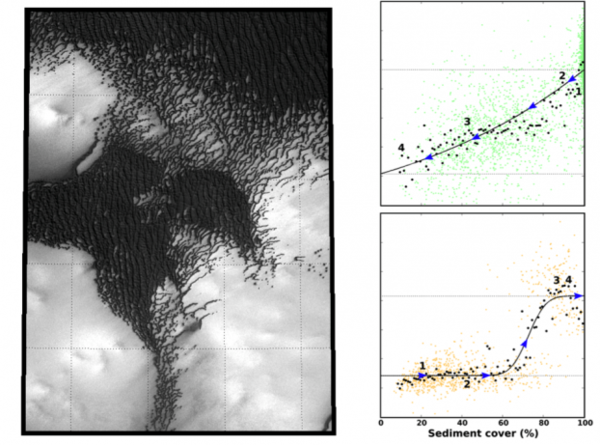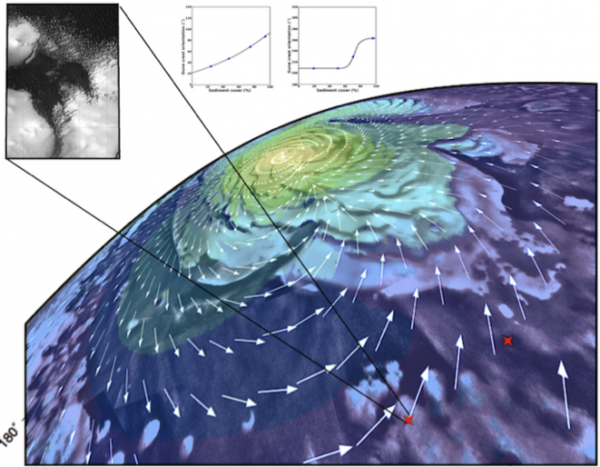Dune morphodynamics around the polar cap of Mars
Researchers from the Institut de Physique du Globe de Paris (IPGP) and the Université Paris-Diderot in collaboration with climatologists from the Laboratoire de Météorologie Dynamique (LMD) have just developed a method to trace wind conditions from the morphodynamics of the dunes on the surface of Mars. Their method is valid under any conditions and can therefore be applied as well on Earth, on Mars as on Titan. In their article published in the journal Earth and Planetary Science Letters, scientists were particularly interested in the Martian circumpolar region.
The idea that dune systems provide unique information on wind patterns at the surface of planetary bodies, where there are no direct meteorological data as there are on Earth, is not new. However, ascending to the wind regime from the dunes is not easy. To meet this challenge, a team of researchers from the Institut de Physique du Globe de Paris and the Laboratoire de Météorologie Dynamique measured and analyzed dune systems located in the Olympia Undae region near the northern polar ice cap on Mars using satellite data provided by NASA’s Mars Reconnaissance Orbiter probe. In particular, the team was not only interested in the orientation of the dunes, as is traditionally the case, but also in the sedimentary cover, i.e. the availability of wind sediment.
For the first time, the analysis of these data revealed a relationship between sediment availability, i.e. sand grain input and dune structure orientation (dune ridges). Thus, this study attests to two modes of transitions an abrupt and a gentle one that correspond respectively to the dunes that migrate towards an accumulation basin of wind sediments and to the dunes that eject from it. Based on these new observations and a dune morphodynamic model, the researchers solved the opposite problem, allowing them to go back to wind conditions explaining the measurements.
Wind-driven sedimentary flow around the Martian polar cap. A.LUCAS – IPGP, LMD
From these results, the study shows that variations in the albedo of the surface around the Martian polar ice cap are responsible for strong gradients in wind dynamics that are not modelled to date in global climate circulation models (GCM). For example, researchers have developed a new method to constrain wind patterns on the surface of Mars that can help climatologists better model climate on planets with atmospheres.
 In the surroundings of Olympia Undae, the dunes which collide with a dense field present a brutal transition in the orientations of the ridges, while those which escape the bottom in a gradual way. © A.LUCAS – IPGP ; image CTX: MSSS/JPL-NASA
In the surroundings of Olympia Undae, the dunes which collide with a dense field present a brutal transition in the orientations of the ridges, while those which escape the bottom in a gradual way. © A.LUCAS – IPGP ; image CTX: MSSS/JPL-NASA
Source
L. Fernandez-Cascales, A. Lucas, S. Rodriguez, X. Gao, A.Spiga, C.Narteau,
First quantification of relationship between dune orientation and sediment availability, Olympia Undae, Mars
Earth and Planetary Science Letters, Volume 489, 1 May 2018, Pages 241-250
Contacts
Antoine Lucas , IPGP (CNRS/Paris Diderot/Sorbonne Paris Cité) Tél. : 01 57 27 53 07
Clément Narteau , IPGP (CNRS/Paris Diderot/Sorbonne Paris Cité), Tél. : 01 83 95 74 23
Sébastien Rodriguez, IPGP (CNRS/Paris Diderot, Sorbonne Paris Cité), Tél. :06 87 00 20 18
Aymeric Spiga , LMD-IPSL (CNRS/Sorbonne Université, ENS, Ecole Polytechnique), Tél. : 01 44 27 28 47

